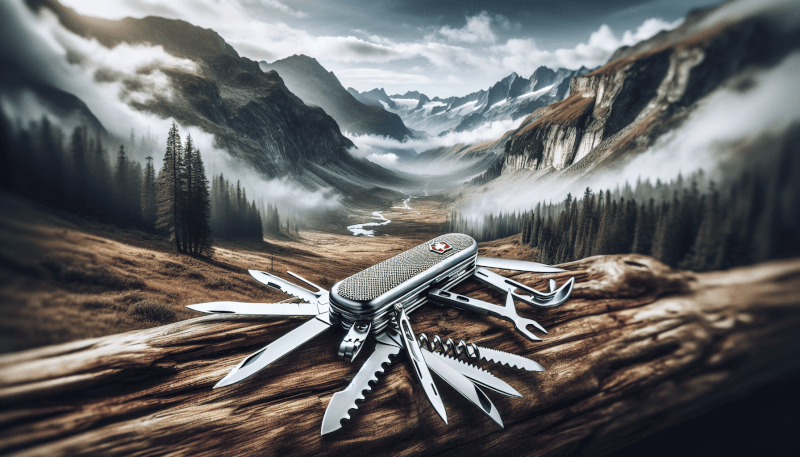Whether you’re an avid outdoors enthusiast or a novice camper, having the right skills for surviving in the wilderness is essential. From knowing how to set up a sturdy tent to cooking over an open fire, mastering these camping skills can ensure a safe and enjoyable experience in nature. In this article, we will explore some of the best camping skills that will equip you with the knowledge and confidence to venture into the wild and make the most out of your camping adventures. So grab your backpack, lace up your boots, and let’s discover the secrets to thriving in the great outdoors.

Building a shelter
When it comes to surviving in the wilderness, one of the most important skills you need to master is building a shelter. Choosing a suitable location is the first step in shelter construction. Look for a spot with natural protection, such as the leeward side of a hill or a dense tree canopy. Avoid low-lying areas that can be prone to flooding.
There are different types of shelters you can build depending on the available resources and your needs. One common type is a debris shelter, which is constructed using natural materials like leaves, branches, and moss. This type of shelter is effective at providing insulation and protection from the elements.
Another type of shelter is a lean-to shelter, which is a simple structure supported by one or two trees with a slanted roof. It is easy to construct and provides good protection from rain and wind. A tarp shelter is also a great option as it is lightweight, easy to set up, and provides excellent protection from the elements.
Finding and purifying water
Finding a reliable water source is crucial for survival in the wilderness. Look for signs of water such as lush vegetation, animal tracks, or areas with damp soil. Common sources of water include rivers, streams, ponds, and natural springs. Remember to avoid stagnant water or sources that might be contaminated.
After finding water, it is important to purify it before drinking to remove harmful bacteria and parasites. There are several methods for purifying water. One effective method is building a solar still, which involves using the sun’s heat to evaporate water and then collecting the condensed vapor.
Using water purification tablets is another convenient method. These tablets contain chemicals that kill bacteria and viruses. Simply drop the tablet into the water and wait for the specified time before drinking. If you don’t have tablets, constructing a basic water filter using materials like sand, gravel, and charcoal can also help remove impurities.
Starting a fire
A fire is not only essential for keeping warm in the wilderness but also for cooking food, purifying water, and signaling for help. Choosing the right location for a fire is crucial for safety. Look for a spot away from dry vegetation, overhanging branches, and any potential fire hazards.
Gathering appropriate firewood is the next step. Look for dry, dead wood that is easy to break or snap. Collect different sizes of firewood, including tinder (small, dry materials that catch fire quickly), kindling (small sticks), and fuelwood (larger logs).
Different fire-starting techniques can be employed depending on the available resources. Using a fire starter kit, such as waterproof matches, a lighter, or a ferro rod, is a reliable option. Also, mastering the skill of making a fire with a bow drill, which involves using friction to create an ember, can be a valuable survival skill in situations where matches or lighters are not available.
Campfire cooking
Cooking meals over a campfire can be a rewarding experience in the wilderness. Start by selecting the right cooking equipment. Lightweight and portable options like a camping stove or a Dutch oven are popular choices. You can also opt for traditional methods like using a tripod and hanging a pot over the fire.
Gathering cooking fuel is essential to keep the fire going. Look for dry wood that burns well and produces hot coals. Dead branches, twigs, and pine cones are excellent sources of fuel. Avoid using green or damp wood as it can generate excessive smoke and result in inefficient cooking.
Campfire cooking techniques vary depending on the type of food and equipment you have. Grilling, boiling, and baking are common methods. It’s important to be mindful of limited resources and plan meals accordingly. Consider using one-pot meals or preparing food that doesn’t require extensive ingredients or cooking time.
Using a reflector oven is another option for campfire cooking. This specialized piece of equipment efficiently reflects heat towards the food, allowing for even baking and roasting. It is especially useful when cooking bread, fish, or other delicate items.

Navigating without a compass
While a compass is a valuable tool for wilderness navigation, there may be situations where you find yourself without one. In these cases, it’s crucial to know alternative methods of navigation. Natural navigation techniques rely on observing and interpreting the environment around you.
Tracking the sun’s movement is one such technique. With knowledge of the sun’s direction based on the time of day, you can determine east and west. Shadows can also provide valuable information. In the Northern Hemisphere, shadows will generally point roughly north during the morning and south during the afternoon.
Identifying landmarks and natural indicators can help you maintain a sense of direction. Recognize distinct features such as mountains, rivers, or unique rock formations. Pay attention to the slope of the land, as it can provide clues about the general direction.
Using the stars as navigation aids is common at night. Learn to identify constellations like the Big Dipper or the North Star (Polaris) to find north. The North Star is especially useful for determining direction in the Northern Hemisphere as it remains relatively stationary.
Creating and using a homemade compass can also assist in navigation. Magnetize a needle by rubbing it against a magnet or piece of metal and then float it on a leaf or in a container of water. The needle will align itself with the Earth’s magnetic field, indicating north and south.
Identifying edible plants and foraging
Foraging for edible plants is a valuable skill in survival situations or when resources are scarce. However, it’s crucial to have a solid understanding of the basics before venturing into foraging. Educate yourself on the edible plants that are common in the area where you will be camping.
Identifying common edible plants is a key component. Look for plants like dandelions, cattails, stinging nettle, or wild berries, as they are often abundant and nutritious. Consider investing in a guidebook or taking a course on wild edible plants to enhance your knowledge and confidence in identifying them.
Testing plants for edibility is a critical step. Before consuming any part of a plant, perform a skin contact test, a lip contact test, and a small taste test to check for adverse reactions. Gradually increase the amount ingested if there are no negative effects. It is always safer to consult an expert or avoid consuming a plant if you have any doubts.
Preparing and cooking foraged food is important to eliminate potential toxins, improve taste, and increase digestibility. Remove any inedible parts, such as thorns or tough stems, and cook greens to reduce bitterness and potential toxicity. Boiling or steaming are common cooking methods for foraged plants.
It is crucial to avoid poisonous plants during foraging. Familiarize yourself with common toxic plants in your area and learn to identify their distinguishing features. If in doubt, do not consume the plant. Make sure to practice ethical foraging by only taking what you need and leaving enough for local wildlife.

Wilderness first aid
Accidents and injuries can happen in the wilderness, so having knowledge of basic first aid is essential for survival. Knowing and assessing common injuries is the first step. Learn to recognize the signs of cuts, burns, sprains, fractures, and hypothermia. Understanding when to seek additional medical help is crucial.
Creating a first aid kit for wilderness trips is important. Stock it with essentials like bandages, adhesive tape, antiseptic wipes, sterile gauze pads, splints, pain relievers, insect repellent, and a first aid manual. Customize the kit to suit your specific needs and the environment you’ll be in.
Treating cuts, burns, and sprains requires basic first aid knowledge. Clean wounds with clean water, and apply sterile bandages to prevent infection. For burns, hold the affected area under cool running water and cover with a sterile nonstick dressing. Treat sprains by immobilizing the injured joint with a splint or wrap.
Dealing with insect bites and stings is common in the wilderness. Apply insect repellent before venturing out, and if bitten, clean the area with soap and water. Remove any bee or wasp stingers carefully using a credit card or similar flat object. Apply a cold compress to reduce swelling and take antihistamines if necessary.
Recognizing and treating hypothermia is vital, especially in cold environments. Look for symptoms such as intense shivering, confusion, drowsiness, and loss of coordination. Move the affected person to shelter, remove wet clothing, and provide warm, dry layers. Warm drinks and body-to-body contact can also help raise body temperature.
Basic survival knots
Knowing how to tie essential knots is a valuable skill in various survival situations. Knots help secure shelters, hold equipment in place, and perform other essential tasks. The square knot, bowline, and clove hitch are three basic knots that everyone should learn.
Understanding the importance of knots is crucial. A secure knot can make a significant difference in the stability and safety of a shelter or gear secured with a rope. Take the time to practice knots until they become second nature.
The square knot is useful for joining two ropes of equal diameter. It is reliable and easy to tie. The bowline is a versatile loop knot that is used for a variety of purposes, such as securing a rope to a tree or creating a fixed loop. The clove hitch is commonly used for attaching a rope to a post or pole.
Tying knots for shelter building is essential for stability. Use the square knot to tie together branch intersections or to secure two poles together. The clove hitch can be used to secure a rope to a tree trunk or a stake, providing additional support for the shelter.
Securing equipment and gear with knots is important to prevent accidental loss or damage. Use the bowline knot to create a loop around the object to be secured and then secure it with additional knots or lashings. This ensures that your gear remains in place even in windy or turbulent conditions.
Practicing knot-tying skills is essential to master this important survival technique. Start by learning the basic knots and practice tying them until you can confidently tie them without hesitation. Regularly refresh your skills to ensure you can tie knots quickly and accurately in high-pressure situations.

Setting up bear-safe campsites
When camping in areas where bears are present, it is crucial to take precautions to minimize bear encounters and ensure the safety of both humans and bears. Understanding bear behavior and habitats is the first step in setting up bear-safe campsites.
Choosing appropriate camping areas can significantly reduce the chances of encountering bears. Look for established campsites that have bear-resistant food storage containers or poles. Avoid areas near bear feeding areas, carcasses, or dense berry patches, as these can attract bears.
Storing food and scented items securely is essential. Use bear-resistant containers or hang bear bags at least 100 feet away from your sleeping area and at least 10 feet above the ground. Store all food, cooking utensils, toiletries, and garbage in these secure containers to eliminate odors and prevent bears from being attracted to your campsite.
Hanging bear bags involves using a rope to suspend a bag filled with food and scented items from a high branch. The bag should be at least 4 feet away from the trunk and 10 feet off the ground. Follow proper hanging techniques to ensure the bag is beyond the reach of bears.
Using bear canisters is an alternative to hanging bear bags. These sturdy containers are designed to prevent bears from accessing food. Place all food and odorous items inside the canister and secure it at least 100 feet away from your sleeping area.
Implementing bear safety precautions is vital to minimize the risk of bear encounters. Avoid cooking and eating near your sleeping area to prevent attracting bears with food smells. Keep a clean camp, disposing of garbage and cleaning up food scraps promptly. Make noise while hiking to alert bears of your presence.
Managing wildlife encounters
Encountering wildlife is an inevitable part of camping and exploring the wilderness. Understanding common wildlife hazards and knowing how to react can help ensure your safety and minimize potential conflicts.
Identifying and avoiding common wildlife hazards is crucial. Learn about the wildlife species that are native to the area where you’ll be camping and educate yourself on their behavior. This knowledge will help you identify potential hazards and take steps to avoid them.
Understanding animal behavior and signs can provide valuable information. Learn to recognize signs of aggression or distress, such as raised hair or feathers, vocalizations, or defensive displays. Avoid approaching wildlife, especially when they have offspring or are displaying signs of stress.
Using bear spray and other wildlife deterrents is an effective way to protect yourself in wildlife encounters. Bear spray is a chemical deterrent specifically designed to deter bears. Carry it in an easily accessible location and know how to use it effectively. Other deterrents, such as noise-making devices or bright lights, can also be useful in certain situations.
Reacting to encounters with aggressive animals is crucial. Never run from a predatory animal, as this can trigger a chase response. Instead, try to appear larger by raising your arms and standing tall. Back away slowly and avoid direct eye contact. If attacked, fight back vigorously, targeting sensitive areas like the nose or eyes.
Securing and protecting your camp from wildlife intrusion is important. Store all food and scented items securely to prevent animals from being attracted to your campsite. Keep your sleeping area clean of any food residues or scraps that might entice wildlife. Make noise when moving around the camp to alert animals to your presence.



